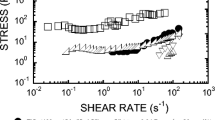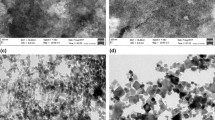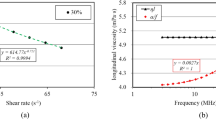Abstract
A novel approach to the analysis of the electrorheological effect is proposed, based on the expansion of dimensionless relative shear stress as function of electric field strength in the power series \( {\tau}_{\mathrm{rel}}=\frac{\tau_E}{\tau }=1+\frac{\alpha }{\tau }E+\frac{\beta }{\tau }{E}^n \). The application of this approach to investigation of the electrorheological effect in suspensions of isotropic and needle-like CeO2 nanoparticles in polydimethylsiloxane has revealed that the polynomial coefficients can be judged as a measure of the efficiency of transformation of electrical energy into mechanical energy. The values of α and β coefficients depend on the shape and concentration of filler particles, as well as on the shear rate. The value and the sign of these coefficients determine both the magnitude of the electrorheological effect and the type of dependence of the shear stress (linear or power law) on the strength of the electric field. It has been shown that the values of α and β coefficients for the electrorheological fluids with needle-like particles are greater than for fluids with isotropic particles (at the same concentration of suspensions), which is associated with the different polarization of particles in the applied electric field.

A novel approach to the analysis of the electrorheological effect is proposed.






Similar content being viewed by others
References
Agafonov AV, Zakharov AG (2010) Electrorheological fluids. Russ J Gen Chem 80:567–575
Agafonov AV, Krayev AS, Davydova OI, Ivanov KV, Shekunova TO, Baranchikov AE, Ivanova OS, Borilo LP, Garshev AV, Kozik VV, Ivanov VK (2016) Nanocrystalline ceria: a novel material for electrorheological fluids. RSC Adv 6:88851–88858
Choi HJ, Jhon MS (2009) Electrorheology of polymers and nanocomposites. Soft Matter 5:1562–1567
Crassous JJ, Mihut AM, Wernersson E, Pfleiderer P, Vermant J, Linse P, Schurtenberger P (2014) Field-induced assembly of colloidal ellipsoids into well-defined microtubules. Nat Commun 5:5516
Davydova OI, Kraev AS, Redozubov AA, Trusova TA, Agafonov AV (2016) Effect of polydimethylsiloxane viscosity on the electrorheological activity of dispersions based on it. Russ J Phys Chem A 90:1269–1273
Duan X, Luo W, Chen H, He Y (2000) The effect of particle shape on water-free mica ER fluids. J Intell Mater Syst Struct 11:43–46
Feng P, Wan Q, Fu XQ, Wang TH, Tian Y (2005) Anomalous electrorheological behavior of ZnO nanowires. Appl Phys Lett 87:033114
Halsey TC (1992) Electrorheological fluids. Science 258:761–766
Hao T (2001) Electrorheological fluids. Adv Mater 13:1847–1857
Hong J-Y, Choi M, Kim C, Jang J (2000) Geometrical study of electrorheological activity with shape-controlled titania-coated silica nanomaterials. J Colloid Interface Sci 347:177–182
Ji Z, Wang X, Zhang H, Lin S, Meng H, Sun B, George S, Xia T, Nel AE, Zink JI (2012) Designed synthesis of CeO2 nanorods and nanowires for studying toxicological effects of high aspect ratio nanomaterials. ACS Nano 6:5366–5380
Kanu RC, Shaw MT (1998) Enhanced electrorheological fluids using anisotropic particles. J Rheol 42:657–670
Kor YK, See H (2010) The electrorheological response of elongated particles. Rheol Acta 49:741–756
Kun-Quan L, Rong S, Xue-Zhao W, Gang S, Wei-Jia W, Ji-Xing L (2006) Polar molecule dominated electrorheological effect. Chin Phys 15:2476–2480
Liu YD, Choi HJ (2012) Electrorheological fluids: smart soft matter and characteristics. Soft Matter 8:11961–11978
Mittal M, Furst EM (2009) Electric field-directed convective assembly of ellipsoidal colloidal particles to create optically and mechanically anisotropic thin films. Adv Funct Mater 19:3271–3278
Moradian N, Ting DS-K, Cheng S (2009) The effects of free stream turbulence on the drag coefficient of a sphere. Exp Thermal Fluid Sci 33:460–471
Mrlik M, Pavlinek V (2016) Magnetorheological suspensions based on modified carbonyl iron particles with an extremely thin poly(n-butyl acrylate) layer and their enhanced stability properties. Smart Mater Struct 25:085011
Otsubo Y (1999) Electrorheology of whisker suspensions. Colloids Surf A Physicochem Eng Asp 153:459–466
Parthasarathy M, Klingenberg DJ (1996) Electrorheology: mechanisms and models. Mater Sci Eng RI7:57–103
Peer P, Stenicka M, Sedlacik M, Filip P, Pavlinek V (2016) Magnetorheological behaviour and electrospinning of poly(ethylene oxide) suspensions with magnetic nanoparticles. J Intell Mater Syst Struct 27:898–903
Pokrovskiĭ VN (1972) Stresses, viscosity, and optical anisotropy of a moving suspension of rigid ellipsoids. Sov Phys Usp 14:737–746
Qi Y, Wen W (2002) Influences of geometry of particles on electrorheological fluids. J Phys D 35:2231–2235
Ramos-Tejada MM, Espin MJ, Perea R, Delgado AV (2009) Electrorheology of suspensions of elongated goethite particles. J Non-Newtonian Fluid Mech 159:34–40
Ramos-Tejada MM, Arroyo FJ, Delgado AV (2010) Negative electrorheological behavior in suspensions of inorganic particles. Langmuir 26:16833–16840
Sedlacik M, Mrlik M, Kozakova Z, Pavlinek V, Kuritka I (2013) Synthesis and electrorheology of rod-like titanium oxide particles prepared via microwave-assisted molten-salt method. Colloid Polym Sci 291:1105–1111
Shen R, Wang X, Lu Y, Wang D, Sun G, Cao Z, Lu K (2009) Polar-molecule-dominated electrorheological fluids featuring high yield stresses. Adv Mater 21:4631–4635
Sheng P, Wen W (2012) Electrorheological fluids: mechanisms, dynamics, and micro fluidics applications. Annu Rev Fluid Mech 44:143–174
Shkel YM, Klingenberg DJ (1999) A continuum approach to electrorheology. J Rheol 43:1307–1322
Tan P, Tian WJ, Wu XF, Huang JY, Zhou LW, Huang JP (2009) Saturated orientational polarization of polar molecules in giant electrorheological fluids. J Phys Chem B 113:9092–9097
Wen W, Huang X, Yang S, Lu K, Sheng P (2003) The giant electrorheological effect in suspensions of nanoparticles. Nat Mater 2:727–730
Wen W, Huang X, Sheng P (2008) Electrorheological fluids: structures and mechanisms. Soft Matter 4:200–210
Winslow WM (1947) Method and means for translating electrical impulses into mechanical force. US Patent 2:417–850
Winslow WM (1949) Induced fibration of suspensions. J Appl Phys 20:1137–1140
Wu J, Song Z, Liu F, Guo J, Cheng Y, Ma S, Xu G (2016) Giant electrorheological fluids with ultrahigh electrorheological efficiency based on a micro/nano hybrid calcium titanyl oxalate composite. NPG Asia Mater 8:e322
Yin J, Zhao X (2006) Titanate nano-whisker electrorheological fluid with high suspended stability and ER activity. Nanotechnology 17:192–196
Yin J, Zhao X (2011) Electrorheology of nanofiber suspensions. Nanoscale Res Lett 6:256
Yin J, Zhao X, Xiang L, Xia X, Zhang X (2009) Enhanced electrorheology of suspensions containing sea-urchin-like hierarchical Cr-doped titania particles. Soft Matter 5:4687–4697
Zhang K, Liu YD, Jhon MS, Choi HJ (2013) Generalized yield stress equation for electrorheological fluids. J Colloid Interface Sci 409:259–263
Funding
This study was financially supported by Russian Science Foundation (Project no. 16-13-10399). The research was performed using the equipment of the JRC PMR IGIC RAS.
Author information
Authors and Affiliations
Corresponding author
Electronic supplementary material
ESM 1
(DOCX 251 kb)
Rights and permissions
About this article
Cite this article
Agafonov, A.V., Kraev, A.S., Ivanova, O.S. et al. Comparative study of the electrorheological effect in suspensions of needle-like and isotropic cerium dioxide nanoparticles. Rheol Acta 57, 307–315 (2018). https://doi.org/10.1007/s00397-018-1076-x
Received:
Revised:
Accepted:
Published:
Issue Date:
DOI: https://doi.org/10.1007/s00397-018-1076-x




